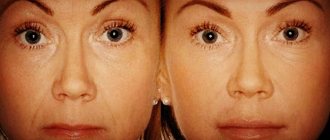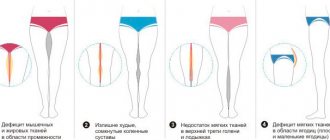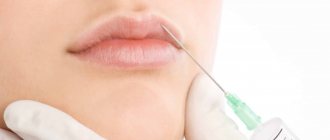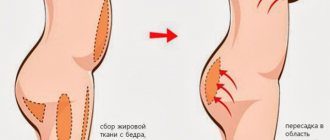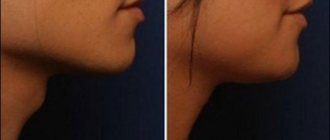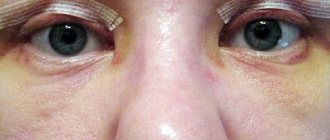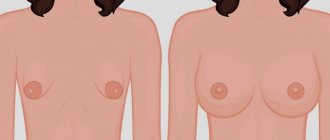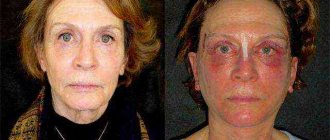What it is?
Lipofilling (from the Greek “lipos” - fat, “filing” - to fill) is a correction of facial and body contours, the essence of which is to transplant the patient’s fat tissue from one area of the body to another.
In fact, this is not the kind of operation that people usually imagine. Fat grafting is a series of special injections . They can be performed without resorting to anesthesia, only under local anesthesia. First, fat is directly collected using a blunt-nosed needle from the fatty tissue of the abdomen or inner thigh. These areas contain the necessary and most useful material for rejuvenation, since it has the most suitable structure for transplantation and contains many stem cells.
After this, the fat goes through several stages of purification. It is then filled into syringes and injected into the desired area. Plastic surgeons and cosmetologists perform lipofilling.
Below is an informative video about lipofilling:
The lipofilling procedure has certain features depending on the area where it is performed. Read about lipofilling of the buttocks, nasolabial folds, lips, arms and intimate areas, lower and upper eyelids, cheekbones, chin, neck and nasolacrimal groove, mammary glands, as well as legs and calf muscles.
Indications
Lipofilling helps fight the signs of old age and correct individual parts of the body. Indications for the procedure:
- the presence of folds and wrinkles;
- dry and inelastic skin;
- irregular face shape – cheeks and cheekbones, bags under the eyes, thin lips;
- presence of the effect of an exhausted face;
- need for breast augmentation;
- the patient’s desire to correct the shape of the hips;
- curvature of the legs;
- the need for rejuvenation of the skin of the hands.
With the help of lipofilling you can correct various problems
Note! In addition to rejuvenation from an aesthetic point of view, there are other regenerative indicators. Regeneration is the restoration of the natural state of tissues after receiving various damages. Lipofilling can help if there are scars and other damaged areas on the skin.
Photos before and after
In the photo below you can see what the face looks like before and after the procedure.
Results of the procedure
In the photographs above you can see the positive result after lipofilling. The face looks much younger and fresher. Sunken cheekbones have become plumper, tear grooves are less noticeable, the skin is elastic and healthy.
You can notice that after lipofilling, nasolabial wrinkles smoothed out, and visually the lips began to look healthier and plumper . In general, the result was positive, the patient began to look much younger and more beautiful. It is important that correction of a specific area of the face gives excellent results for the entire face as a whole.
Breast correction
It is important to understand that bust lipofilling is not the same as full-fledged plastic surgery. With lipofilling surgery, you can enlarge your breasts by one size.
However, experts recommend carrying out this procedure not for the sake of enlargement, but for the sake of correcting various irregularities in order to give the breast a beautiful aesthetic appearance.
Breast shape can also be corrected using lipofilling
Advantages
Today, the procedure is becoming more and more popular (mainly among older people for rejuvenation purposes, but sometimes for medical reasons), since it is a relatively safe operation.
- Since the patient's own fat cells are used for lipofilling, it does not cause any allergies or tissue rejection. Therefore, the transplant is carried out practically without preliminary consultations, which saves the patient’s time and money (but before lipofilling you will still have to donate blood for some tests).
- The resulting result looks as natural as possible in comparison with other plastic surgery options.
The advantages of this technique are obvious:
- Possibility of preventing the occurrence of allergic reactions to the transplant, since the client’s own tissues are used.
- The likelihood of fat tissue rejection is much lower than with artificial implants.
- After the operation, the “tweaked” area looks as natural as possible.
- The so-called “double hit”: one problem area is reduced due to the removal of excess fat, and after its transplantation, another part of the body is pleasantly rounded.
- The operations are low-traumatic and very well tolerated by patients.
- The procedure often does not require general anesthesia.
About the technique in the video
Alternative and minimally invasive techniques:
- Contour plastic
- Thread lifting
Flaws
Although the procedure is considered safe and effective, there is still a certain risk of some complications :
The appearance of severe swelling.- Bruises at the sites where fatty tissue is taken and inserted.
- Numbness of the skin in the donor areas (occurs rarely, then quickly disappears).
- Pain syndrome (usually stops soon).
- Asymmetry and unevenness of the skin surface in the area of fat injection. This is a temporary phenomenon that goes away after the swelling subsides and the excess injected fat is absorbed. However, if the form does not recover for more than a few months, then it is worth contacting a specialist.
- Infection (in exceptional cases).
- In very rare cases, complete resorption of the adipose tissue and no effect from the operation. It depends individually on the individual patient’s body.
- Disturbance of pigmentation at the sites of fat injection.
To avoid such consequences, it is recommended to choose a good specialist. It is best to work with an experienced surgeon who approaches his work competently and responsibly, and it is also advisable to review his previous results of operations and procedures.
Do not forget that most of the successful correction depends on the doctor. Plus, following the care and doctor’s instructions after lipofilling is completed plays a big role.
Eyelid lipofilling: how the operation works
Lipofilling of the eyelids is a minimally invasive surgical intervention aimed at correcting the eyelids and tissues of the periorbital area. It occurs by transplanting the patient's autologous fat graft into the area around the eyes. Lipofilling of the eyelids consists of three procedures: taking fat from the donor area, processing adipocytes (fat cells) for their better engraftment in a new place and directly introducing viable cells into a pre-designated area around the eyes.
Despite its growing popularity, lipofilling of the eyelids still raises a number of doubts about the successful outcome. The main questions that patients ask is uncertainty about the survival of fat cells. It is important to understand here that the viability of adipocytes will depend on the method of their collection from the donor part of the patient's body. The removal of fat cells is called liposuction, and it can be done using various methods. The most modern methods are those that operate on the principle of cytosparing technology (cito in Latin - cell). For example, ultrasound technology allows you to gently and without trauma separate fat cells in entire clusters (clusters) from surrounding tissues without damaging the cells themselves or nearby vessels and nerves. An ultrasonic wave of a certain frequency acts on the liquid of a previously introduced tumescent solution, the bubbles of which, bursting from ultrasonic vibrations, separate fat cells from neighboring tissues.
After separation, the fat cells enter a hollow cannula tube, and from there into a reservoir in which they will be processed. Lipofilling of the eyelids requires complete sterility of the entire operation to avoid infection of the material. If all medical protocols are followed and liposuction is performed using the latest generation equipment, the cells will remain 80-85% viable. Lipofilling of the eyelids is an operation where the doctor’s qualifications are very important, since only experience and excellent knowledge of anatomy will prevent common mistakes common to beginners. For example, donor areas are not all equally effective for transplantation into the periorbital region. Fat from the patient's knees is predominantly used, as it is most suitable for this task. It should be small enough and take root well in the facial area.
After processing the fat cells, the autograft is transplanted using the thinnest cannulas into pre-marked areas. Lipofilling of the eyelids requires a very delicate intervention; therefore, flexible cannulas with round tips are used, capable of bypassing even blood vessels and nerves. With a highly qualified doctor, hematomas and tissue trauma can be practically avoided. Access points for cannulas in the skin are minimal punctures that will not be visible after healing.
Swelling after the procedure - causes and prevention
Swelling, unlike all other symptoms accompanying the postoperative condition, manifests itself in any case without exception . The reason lies in the reaction of tissues to injury, inflammation, as well as temporary lymphostasis - a violation of the outflow of fluid from tissues, since when fat is introduced, the volume of the receiving zone greatly increases and pressure occurs on the veins and lymphatic vessels.
Swelling does not appear immediately, but only 24 hours after the procedure and reaches its maximum on the third day. This is due to a decrease in blood flow in the operation area (by about half). But from day 5 the swelling begins to resolve and go away. In the most favorable case, by the end of the first day a slight swelling appears, which no longer grows and disappears after 72 hours.
On average, complete restoration of blood circulation to the initial level is completed by the second month after surgery, and by the fourth month there is a significant increase in blood circulation, which corresponds to the desired rejuvenation effect.
Swelling may recur:
- due to excessive consumption of too spicy, sweet or salty foods;
- due to premenstrual syndrome, overheating, heavy physical activity;
- excessive consumption of alcohol, tobacco, etc.
Story
In 1987, New York surgeon Sidney Coleman began developing this method. During his work, he saw that transplanting one’s own fat is safe and extremely effective, because it will not be rejected by the body. The doctor researched that the procedure has a beneficial effect on the skin at the transplant site - it becomes elastic, its color becomes healthier.
At the same time, given the body’s “perceptibility” of the transplanted fat, doctors for a long time could not understand another problem that had arisen. The fact is that the body, accepting the transplanted fat, absorbed it in an amount of fifty to eighty percent. It follows from this that to maintain the desired appearance, a single operation will not be enough; a number of procedures will be required.
The body absorbs more pure transferred fat
The fat was taken with a thin tube with an elastic needle, which made it possible to get to the layer where the best material, from the point of view of transplantation, is located. Then this fat was processed and purified, vitamins were added, but it was still absorbed by at least half.
The solution was found by Coleman, already familiar to us. He added platelet-rich plasma to the transplanted fat, achieving a ninety percent acceptance rate of the new material. Plasma promotes the appearance of new blood vessels that produce oxygen. Without this, the cells died within 24 hours. This problem has been the cause of previous failed surgeries.
This plasma method was patented by Coleman. Today, all over the world the procedure is known as fat grafting.
This procedure is known all over the world as fat grafting.
Rehabilitation
Lipofilling is performed with virtually no damage to any tissue and with minimal blood loss , so the patient can go home almost immediately after it (that is, the procedure is completely outpatient). Physical activity is limited for some time, usually for a couple of weeks, depending on the extent of the procedure performed. The bandage can be removed after 2-3 days. There are never any seams left.
Small hematomas remain at the site where the fatty tissue is injected. They usually go away within a couple of days. If all this is accompanied by severe pain, then painkillers may be prescribed.
A light gray fluid may ooze from the wound . This complication is treated with lotions, pressure bandages and physiotherapeutic procedures.
Results are usually noticeable 2-3 days after the procedure. The final result takes longer to complete. After the procedure, you should strictly follow the doctor’s instructions and recommendations so as not to worsen the result.
Restrictions
As for restrictions on lipofilling, there are two types: absolute and relative. The absolute ones include:
- worsening chronic diseases;
- infections;
- blood clotting problems;
- inflammatory processes and injuries;
- oncological diseases;
- diabetes.
This procedure is not performed for diabetics.
Note! There are much more relative restrictions. The doctor can perform surgery on them, but the risk of various complications will be increased. Examples of such contraindications include smoking and taking certain medications before the procedure.
How long does the effect last?
The result depends on individual characteristics.
In most cases, it persists for 3-4 years (there are cases when the fat is not absorbed until the end of life). Sometimes you have to repeat the procedure. Changes should be assessed no earlier than 3-6 months later (during this time, fat cells will have time to either take root or die off). If after this period the desired effect is still not achieved, then it is recommended to repeat the procedure.
In the future, maintaining the result depends on how well the operation was performed, as well as on the patient’s lifestyle. It should be remembered that active weight loss and bad habits worsen the result, and because of this, fat can completely resolve.
